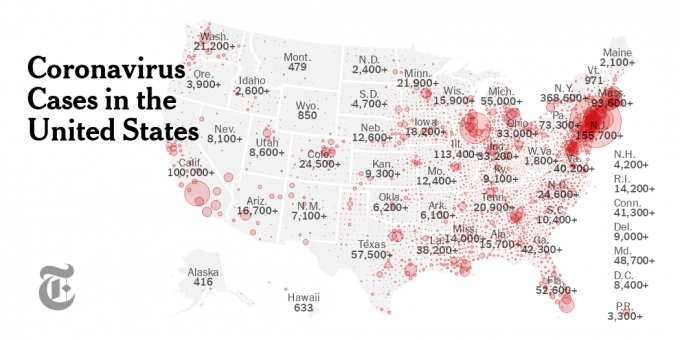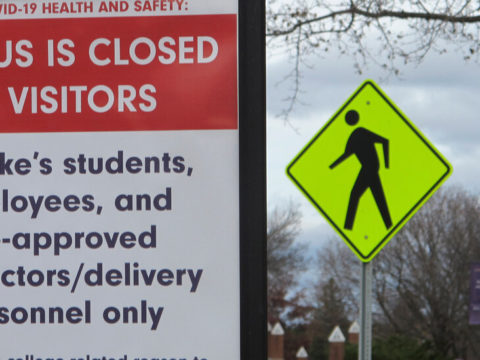
More than 1,699,100 people in the United States have been infected with the coronavirus and at least 99,800 have died, according to a New York Times database.
Reported cases in the United States
Share of population with a reported case
Cases currently doubling every …
7 days
14 days
30 days
Fewer than 20 cases
No cases reported
Double-click to zoom into the map.
Use two fingers to pan and zoom. Tap for details.
Note: The map shows the known locations of coronavirus cases by county. For total cases and deaths: Circles are sized by the number of people there who have tested positive, which may differ from where they contracted the illness. For per capita: Parts of a county with a population density lower than 10 people per square mile are not shaded. Sources: State and local health agencies and hospitals.
Though the number of new deaths has trended downward, the virus continues to circulate widely within the United States. As states move to partly reopen their economies, thousands of new cases are still being identified each day and true normalcy remains a distant vision. Every day, more beloved events are scrubbed from the calendar. There will be no Columbus Scottish Festival in Indiana, no Maine Authors Book Festival, no Western Minnesota Steam Threshers Reunion.
Where new cases are increasing
Mar. 1
May 26
7-day average
California
100,161
total cases
These states have had recent growth in newly reported cases over the last 14 days, in part because some have recently ramped up their testing capacity. The White House released criteria for states to reopen based on a “downward trajectory” of cases over the last 14 days, though it did not define how to measure the trajectory. Scales are adjusted for each state to make the curve more readable.
Where new cases are mostly the same
Mar. 1
May 26
7-day average
New York
369,801
total cases
Where new cases are decreasing
Mar. 1
May 26
7-day average
New Jersey
156,628
total cases
Note: States and territories are grouped according to how the seven-day average of new cases has changed from two weeks ago to today.
In late February, there were just a few dozen known cases in the United States, most of them linked to travel. But by late spring, the virus had torn through every state, infecting more people than the combined populations of Wyoming and Delaware, and killing more Americans than can fit in an N.F.L. stadium. Despite some progress, new hotspots continue to emerge and hundreds more people are dying each day.
Cases and deaths by state and county
| Cases | Per 100,000 | Deaths | Per 100,000 | Case Growth Rate | |
|---|---|---|---|---|---|
| + New York MAP » |
369,801 | 1,901 | 29,339 | 151 |
|
| + New Jersey MAP » |
156,628 | 1,763 | 11,339 | 128 |
 |
| + Illinois MAP » |
113,488 | 896 | 4,960 | 39 |
 |
| + California MAP » |
100,161 | 253 | 3,887 | 10 |
 |
| + Massachusetts MAP » |
93,693 | 1,359 | 6,473 | 94 |
 |
| + Pennsylvania MAP » |
73,646 | 575 | 5,272 | 41 |
 |
| + Texas MAP » |
57,677 | 199 | 1,561 | 5 |
 |
| + Michigan MAP » |
55,544 | 556 | 5,334 | 53 |
 |
| + Florida MAP » |
52,626 | 245 | 2,318 | 11 |
 |
| + Maryland MAP » |
48,748 | 806 | 2,392 | 40 |
 |
Note: Growth rate shows how frequently the number of cases has doubled over the previous seven days. The fastest rate color shows when cases are doubling in less than 3 days, while the slowest rate color shows when cases are doubling much more slowly, once every 30 days or longer. Growth rate not shown for counties with fewer than 20 cases.
See our live coverage of the coronavirus outbreak for the latest news.
American life has been fundamentally reordered because of the virus. Concerts, parades and baseball games have been called off. Unemployment claims have spiked. Some governors have imposed quarantine requirements on Americans who cross state lines. And even as states begin to reopen, officials have warned that the virus was likely to remain a persistent threat.
New reported cases by day in the United States
March
April
May
7-day average
New cases
Note: The seven-day average is the average of a day and the previous six days of data.
New reported deaths by day in the United States
March
April
May
7-day average
New deaths
The New York Times has found that official tallies in the United States and in more than a dozen other countries have undercounted deaths during the coronavirus outbreak because of limited testing availability.
The New York Times is engaged in a comprehensive effort to track the details of every coronavirus case in the United States, collecting information from federal, state and local officials around the clock. The numbers in this article are being updated several times a day based on the latest information our journalists are gathering from around the country. The Times has made that data public in hopes of helping researchers and policymakers as they seek to slow the pandemic and prevent future ones.
See our maps tracking the coronavirus outbreak around the world.
Businesses are reopening
All 50 states have started to reopen their economies in some capacity. But the number of businesses that are back open varies widely from state to state and even county to county.
“You have 50 different governors doing 50 different things,” said Andrew Noymer, an associate professor of public health at the University of California, Irvine. “There will be states that open too soon or states that are too conservative. It is hard to thread the needle.”
In New Jersey, which has the second-most cases per capita, residents remained largely on lockdown, with only certain industries allowed to resume operations. In Connecticut, offices were allowed to open, with masks required and layouts adjusted to ensure social distancing. And in Alaska, where relatively few cases have been identified, but where several visiting workers have tested positive in recent days, restaurants, gyms and other businesses were preparing to return to full capacity.
“It will all be open,” Gov. Mike Dunleavy of Alaska said, “just like it was prior to the virus.”
Many states began to reopen despite not meeting White House guidelines for progress against the virus. And some, like Texas and Minnesota, relaxed restrictions even as case numbers rose.
But governors in more restrictive states have faced increasing pressure, including in Illinois, where some Republican legislators sued the Democratic governor, in Michigan, where a man in Detroit was accused of threatening to kill the Democratic governor and attorney general, and in North Carolina, where President Trump pressed the Democratic governor for assurances that the Republican National Convention in Charlotte could proceed as planned.
Case numbers in North Carolina have risen rapidly in recent days, with many of the new cases concentrated in rural counties.
“Plans are being made by many thousands of enthusiastic Republicans, and others, to head to beautiful North Carolina in August,” Mr. Trump said Monday in a series of Twitter posts. “They must be immediately given an answer by the Governor as to whether or not the space will be allowed to be fully occupied. If not, we will be reluctantly forced to find, with all of the jobs and economic development it brings, another Republican National Convention site.”
Despite troubling trend lines in places like Arizona and Arkansas, and persistently high case numbers in Chicago and Los Angeles, the news in much of the country is encouraging. Reports of new cases have been steady or declining in most states, even as testing becomes more widely available. Around Detroit and New Orleans, where explosive growth stretched hospitals early in the pandemic, the situation has improved dramatically in recent weeks. In Hawaii and Vermont, few new cases are being spotted. And in Massachusetts and Rhode Island, which have some of the highest per-capita infection rates, cases have been trending downward.
Case numbers spike in meatpacking cities
Across the country, production at meatpacking plants and other food processing centers has slowed or stopped because of large outbreaks, including one at a Smithfield facility in South Dakota that sickened more than 1,000 people and three at Tyson facilities in Iowa that sickened hundreds of people.
The Times has identified more than 100 food processing facilities across the country with coronavirus outbreaks. The federal Centers for Disease Control and Prevention said at least 4,900 meat and poultry processing workers had been infected across 19 states, and at least 20 had died. Though outbreaks have been reported in every region of the country, the rural Midwest and South have been especially hard hit.
Some companies, including Smithfield, have refused to answer even basic questions about the size of their outbreaks. And in some places, state and local health officials have also been silent. In Kansas, state officials said there were more than 2,300 meatpacking-related cases and seven deaths spread across 10 clusters, but they refused to name those facilities. In Nebraska, where the National Guard has helped with the mass-testing of meatpacking workers, state and local officials have often refused to provide details. Officials in Virginia, Maryland and North Carolina, among other places, have also not provided that information.
Hot spots: Counties with the highest number of cases per resident
| County | Cases | Per 100,000 | Case Growth Rate |
|---|---|---|---|
| Trousdale, Tenn. | 1,392 | 14,541 |
 |
| Dakota, Neb. | 1,648 | 8,111 |
 |
| Lincoln, Ark. | 975 | 7,119 |
 |
| Nobles, Minn. | 1,488 | 6,813 |
 |
| Colfax, Neb. | 604 | 5,613 |
 |
| Lake, Tenn. | 413 | 5,488 |
 |
| Ford, Kan. | 1,628 | 4,721 |
 |
| Texas, Okla. | 902 | 4,271 |
 |
| Cass, Ind. | 1,588 | 4,170 |
 |
| Bledsoe, Tenn. | 608 | 4,164 |
 |
Note: Table includes the top counties with at least 20 reported cases when adjusted for population.
Small counties with large meatpacking industries have reported some of the country’s highest numbers of cases per capita. In Nobles County, Minn., 631 workers at a pork processing plant have tested positive. In Cass County, Ind., where at least 900 Tyson workers tested positive, the number of known cases surged from roughly 50 to more than 1,400 over three weeks. And in Dakota County, Neb., which has the second-highest per capita infection rate of any American county, roughly one of every 13 residents has tested positive.
The outbreaks have proved devastating to the immigrant communities that often supply much of the labor at those plants, as well as to the farmers who depend on the facilities for their livelihoods.
Mr. Trump recently declared the meatpacking plants to be critical infrastructure, part of an effort to keep the facilities open. But restaurants have already reported meat shortages, many grocery stores have imposed quotas on meat purchases and some farmers have euthanized animals they could not take to market. In central Nebraska, the mayor of Grand Island called for federal help testing employees of his city’s hard-hit JBS USA beef processing plant. And in Illinois, where there have been multiple meatpacking outbreaks, Attorney General Kwame Raoul called for federal action to keep workers safe.
“This executive order lacks meaningful safety measures and puts workers at processing plants at risk,” said Mr. Raoul, a Democrat.
New York: 369,800 cases have been identified
Case numbers in New York and New Jersey, by far the country’s hardest-hit states, have trended steeply downward in recent days. Officials have started implementing plans for a slow, cautious reopening of the economy.
“Anyone who tells you they know the script doesn’t know what they’re talking about,” Gov. Andrew M. Cuomo said recently. “We all wish we did but we don’t.”
The continuing toll of this spring has been immense. People with the virus have died in more than 40 New York counties, including more than 1,400 victims each in Nassau, Suffolk and Westchester Counties. New York City has fared the worst, with thousands of known cases and hundreds of deaths in each borough. Mayor Bill de Blasio compared the pandemic to “many Katrinas.”
Even as the number of new cases has dropped, the city continues to report more than almost anyplace else in the United States. And about 100 children in the state have been treated for a mysterious illness that causes life-threatening inflammation in critical organs and which appears to be connected to the coronavirus.
“This is a truly disturbing situation,” Mr. Cuomo said. “And I know parents around the state and around the country are very concerned about this, and they should be.”
Nearby, New Jersey has also suffered. More than 154,000 people in the state have tested positive for the virus, and more than 11,000 have died. But that state was also seeing signs of progress and beginning to slowly ease restrictions.
“We want to make sure we do it right, responsibly, and that we don’t kill anybody by doing it too fast,” Gov. Philip D. Murphy said Sunday during an interview on CNN’s “State of the Union.”
Though New York and New Jersey have by far had the most cases, other Northeastern states have also seen severe outbreaks. Despite recent improvement, Massachusetts continues to report more than 800 new cases most days. Rhode Island has one of the country’s highest per capita infection rates. And in Connecticut, where 85 deaths had been linked to the virus at the start of April, the death total has now passed 3,600.
See how the rate of deaths has changed over time in different states and countries.
In America’s nursing homes, outbreaks surge
Across the country, a pattern has played out with tragic consistency: Someone gets sick in a nursing home. Soon, several residents and employees have the coronavirus. The New York Times has identified more than 9,000 nursing homes and other long-term care facilities across the United States with coronavirus cases. More than 197,000 residents and staff members at those facilities have contracted the virus, and more than 37,000 have died. That means one third of the deaths in the pandemic have been linked to long-term care facilities.
Older people and those with underlying health problems are most vulnerable to Covid-19, making the consequences of a nursing home outbreak especially devastating. More than 50 deaths have been linked to the virus at a dozen facilities. In California, Florida, Pennsylvania, New York and New Jersey, the virus has been identified in more than 400 long-term care facilities.
The New York Times is tracking the coronavirus at nursing homes and long-term care centers. Do you or a family member live or work in one of these facilities? If so, we’d like to hear from you.
“This disease creates the potential for a perfect storm in a long-term care facility — large groups of vulnerable people living together and a highly transmissible virus that may not cause symptoms in those who care for them,” said Dr. Daniel Rusyniak, the chief medical officer for Indiana’s state social services agency.
Though all sorts of nursing homes have suffered, those with a higher percentage of black and Latino residents have been likelier to be hit with the virus.
Following critical media reports and public pressure, the Trump administration told the operators of the nation’s nursing homes to let patients and their families know if there are cases of the coronavirus within their facilities. The order will require the facilities to report such cases to the Centers for Disease Control and Prevention within about 12 hours or face fines.
Though many of the first coronavirus cases in the United States were tied to overseas travel, localized outbreaks have become increasingly common. New clusters in nursing homes and other settings, including a psychiatric hospital in Nevada and a date-packing facility in California, are emerging each day.
Times journalists have for weeks tracked clusters of cases and deaths across the country. The largest such outbreaks include state prisons in Ohio and Tennessee, a federal prison complex in California, meatpacking plants in the Midwest and an aircraft carrier that was docked in Guam. The deadliest outbreaks have been in nursing homes and other long-term care facilities.
| Cases Connected To | Cases |
|---|---|
| Marion Correctional Institution — Marion, Ohio | 2,439 |
| Pickaway Correctional Institution — Scioto Township, Ohio | 1,791 |
| Trousdale Turner Correctional Center — Hartsville, Tenn. | 1,311 |
| Lompoc Prison Complex — Lompoc, Calif. | 1,111 |
| Smithfield Foods pork processing facility — Sioux Falls, S.D. | 1,098 |
| Cook County jail — Chicago, Ill. | 1,040 |
| Tyson Foods meatpacking plant — Waterloo, Iowa | 1,031 |
| Cummins Unit prison — Grady, Ark. | 1,016 |
| U.S.S. Theodore Roosevelt — Guam | 969 |
| Harris County jail — Houston, Texas | 947 |
Some agencies and facilities have refused to release the numbers of cases or deaths. More than 1,500 inmates and guards have tested positive across New York City’s 10 jails, and 13 deaths have been tied to those facilities, but officials have refused to provide a breakdown for each jail.
Prisons have been overwhelmed by the virus
The Times has counted more than 47,000 coronavirus infections and 485 deaths in inmates and staff at state prisons, federal prisons and local jails. The country’s three largest known coronavirus clusters are in prisons that have more than 1,300 cases each.
Nearly every state prison system has at least one infection among either inmates or staff. Many of the infections have been asymptomatic, suggesting that the problem is more common than is understood. Fear and pessimism has settled in among inmates. Riots in Kansas and Washington State were led by inmates worried about contracting the coronavirus, prison officials said.
Inmates say that they have not been kept informed by prison administrators about correctional officers who have tested positive. That has left prisoners saying they feel especially vulnerable and also concerned that they might be infected and unwittingly passing the virus on to other inmates.
“You can’t really track it and know who had contact with who,” said Dennis McKeithan, a prison inmate in Pennsylvania. “The secrecy is making things more unsafe because people won’t be able to realize, ‘Oh, I had contact with that guy myself,’ and then go ahead and get tested.”
During interviews with more than two dozen inmates across the nation, prisoners say that correctional facilities are responding to the crisis far too slowly. At Wyoming Correctional Facility in Attica, N.Y., Tracy White, 30, said that only workers on the serving line in the prison’s mess hall are required to wear masks covering their nose and mouth.
“A lot of people are nervous, tense, scared,” Mr. White said.
Social distancing, he said, is impossible. Beds are placed three feet apart. As Mr. White spoke over a prison telephone, he said another inmate was on another phone less than two feet away. He said he had cleaned the phone as best as he could, but that he was also wearing a sock on his hand to protect himself from germs.
Elijah McDowell, an inmate in Connecticut, said the sweep of coronavirus through his prison — including the death of several inmates — had made a bleak existence even more grim.
“Every day is nerve-racking,” he said. “I already have to fight things every day, but fighting the coronavirus, it’s not a fair fight because they keep us in the dark about a lot of things.”
At Cook County Jail in Chicago, where nearly 1,000 inmates and staff have been infected, Antonio House said he washed his hands regularly and tried to be as sanitary as possible in order to stay healthy. But he said the strain of being unable to maintain six feet of distance from guards and other inmates who do not always wear masks was at times overwhelming.
“Mentally, it’s rough,” said Mr. House, 45. “It’s scary. I’m fearful because I don’t know how my body will respond if I catch it.”
Several days after the interview, LaSheda Brooks — who is Mr. House’s daughter — said her father had contracted the coronavirus. He is currently recovering, she said.
Cases, deaths continue to mount around Chicago
As some major cities have seen their cases decline, new infections have remained stubbornly high around Chicago. More than 40,000 people in the city have been infected and more than 1,800 have died. Add in the suburbs, and those numbers more than double.
Chicago’s mayor, Lori Lightfoot, said recently that many in her city had defied orders to stay home and hosted large house parties that the police have had to break up. After watching the plight of New York City, Ms. Lightfoot was taking a cautious approach to eventually reopening her city.
“I feel the burden of having to say to people, ‘Stay inside for your own safety,’” said Ms. Lightfoot, who said she hoped the city could start slowly reopening in early June. “But that is the right thing to do.”
As in much of the country, black and Hispanic people have suffered disproportionately in the Midwest. In Michigan, where less than 15 percent of residents are black, about 40 percent of those who died from the virus have been. In South Dakota, where about 7 percent of residents are black or Hispanic, 36 percent of coronavirus patients are members of those groups. And in Illinois, officials said recently that about 60 percent of Hispanic people who were tested for the virus were positive, three times the average for other Illinoisans.
“While we can’t fix generations of disparities in the span of a few months, we must advance equity in our public health response,” said Gov. J.B. Pritzker of Illinois, who said longstanding “obstacles for members of our Latino communities are now amplified in this pandemic.”













